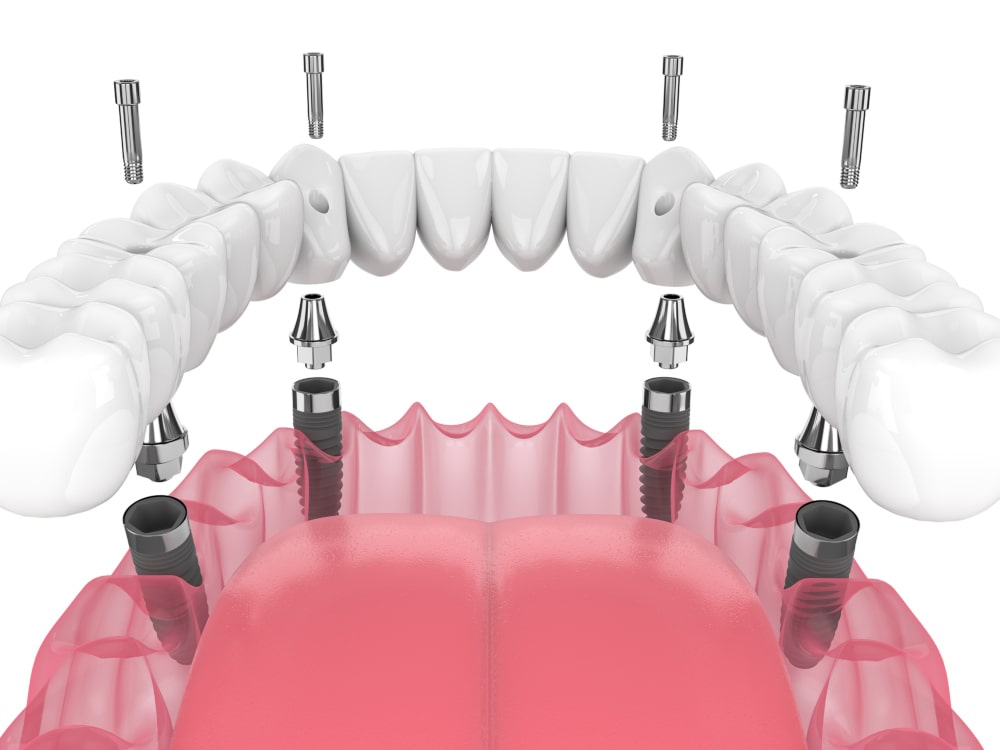
Key Takeaways
For those with significant tooth loss, full-arch restoration provides a reliable, long-term solution to recover a natural-looking, functional smile. This article explains how your dentist can restore a whole arch of lost or badly damaged teeth, offering long-term stability, better dental health, and confidence.
Introduction
Tooth loss does not just make you self-conscious. Not having a full set of healthy teeth can stop you from living a full life. It can affect basic everyday activities, such as chewing, speaking, and smiling confidently. Traditional dentures provide a temporary solution but they shift, causing discomfort and making you feel less confident. Full-arch restoration is a reliable treatment option for permanent restoration of teeth. Read on as we explain the full-arch restoration process, its benefits, and ideal candidates for this life-changing procedure.
What is Full-Arch Restoration?
Full-arch restoration refers to replacing an entire row of teeth in the upper or lower jaw with a fixed prosthesis. While conventional dentures rest on the gums, the prosthesis is held in place by dental implants embedded in the jawbone in a full arch restoration. This helps the prosthesis mimic the aesthetics and function of natural teeth.
Full arch restoration typically utilizes the All-on-4 or All-on-6 technique. Four or six implants are strategically inserted in the jaw to support a full arch of teeth. This provides stability to the prosthesis without the need for individual implants for each missing tooth.
Types of Full-Arch Restoration
Choosing the right option involves understanding the types of implants, prosthetic materials, and whether you prefer a fixed or removable solution.
Implant Options
-
All-on-4: Four implants are strategically embedded in the jawbone to avoid bone grafting. This is ideal for patients with poor bone density.
-
All-on-6: Two additional implants add stability and longevity for people with higher functional demands.
Fixed and Removable Prosthetics
-
Fixed Prosthetics: These are securely attached to the implants. They are the closest to natural teeth in function and appearance.
-
Removable Prosthetics: These are ideal for anyone who wants the option of removing the prosthesis for cleaning.
Materials
-
Zirconia: Zirconia is known for durability and real-life aesthetics.
-
Acrylic: This is a more affordable choice. It is lightweight but may have a shorter lifespan.

Benefits of Full-Arch Restoration
Full-arch restoration offers several advantages over traditional dentures or bridges:
1. Eat and Speak with ease
You can enjoy a wider range of foods and speak with clarity, when you don’t have to worry about your prosthesis slipping or shifting, unlike dentures.
2. Improved Appearance
Custom prosthetic teeth look and function like natural teeth. They restore your facial structure and prevent the sunken appearance caused by tooth loss.
3. Long-Term Stability
The 4 strategically placed implants remain firmly in place, giving you the confidence to laugh, eat, and socialize without worry.
4. Bone Preservation
Dental implants stimulate the jawbone and prevent bone loss (typically associated with missing teeth).
The Full-Arch Restoration Process
Initial Consultation
A comprehensive assessment, including imaging and bone density analysis, is conducted during initial consultation. It helps to determine if you're a candidate for full arch restoration. Preparatory treatments, such as bone grafting, may be necessary in some cases.
Implant Placement
Implants are surgically placed into the jawbone. Temporary prosthetics are attached the same day, providing immediate functional and aesthetic restoration.
Attaching the Final Prosthetic
The patient undergoes a healing period of a few months which allows the implant to be integrated into the jaw bone, in a process known as osseointegration. After that, a custom prosthetic arch is secured to the implants.
Recovery and Aftercare
Proper aftercare, as recommended by your dentist, good oral hygiene and regular dental visits ensure the longevity of your arch restoration.
While full-arch restoration is highly successful, it’s important to understand potential risks:
-
Implant Failure: It is rare but possible in smokers or individuals with uncontrolled diabetes.
-
Jawbone Density: Patients with lack of adequate bone density may require bone grafting.
Consult an experienced dentist to address any concerns and your suitability for the procedure.

Full-Arch Restoration at North York Smile Centre
At North York Smile Centre, we combine advanced technology with compassionate care to deliver outstanding results. From the initial consultation to post-procedure follow-ups, our team is dedicated to ensuring your journey is smooth and successful.
For those struggling with extensive tooth loss, full-arch restoration offers a transformative solution. By restoring both the functionality and aesthetics of a natural smile, this procedure empowers patients to eat, speak, and smile with renewed confidence. Schedule a consultation today to discover how this innovative treatment can change your life.
FAQs
1. How is full-arch restoration different from dentures?
Unlike dentures, full-arch restorations are anchored to dental implants, ensuring a stable, natural feel without adhesives or slipping.
2. How long does the process take?
While the timeline varies, many patients receive temporary prosthetics on the same day as implant placement, with final restorations completed after a healing period.
3. Can I get full-arch restoration with low jawbone density?
Yes, techniques like All-on-4 often work for patients with limited bone density, though additional treatments like grafting may be necessary for severe cases.
4. What maintenance is required?
Daily brushing, flossing, and regular dental check-ups are important to maintain the condition of your implants and prosthetics.
5. Will my restored smile look and feel natural?
Yes! High-quality materials and precise craftsmanship make your new teeth look and function just like the real thing.


